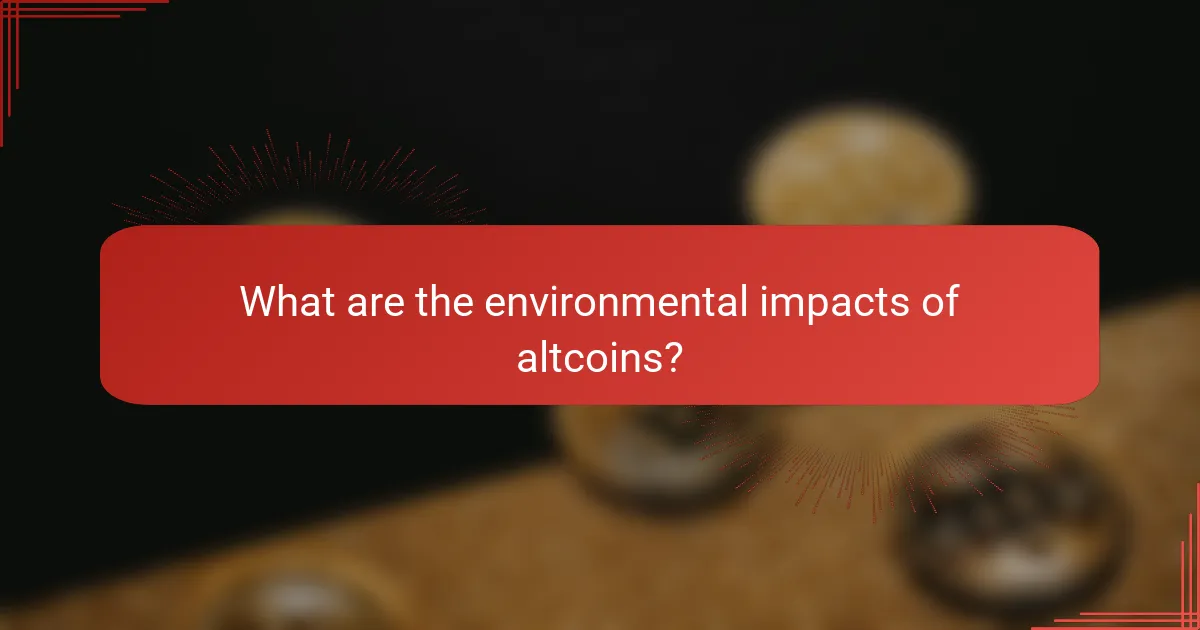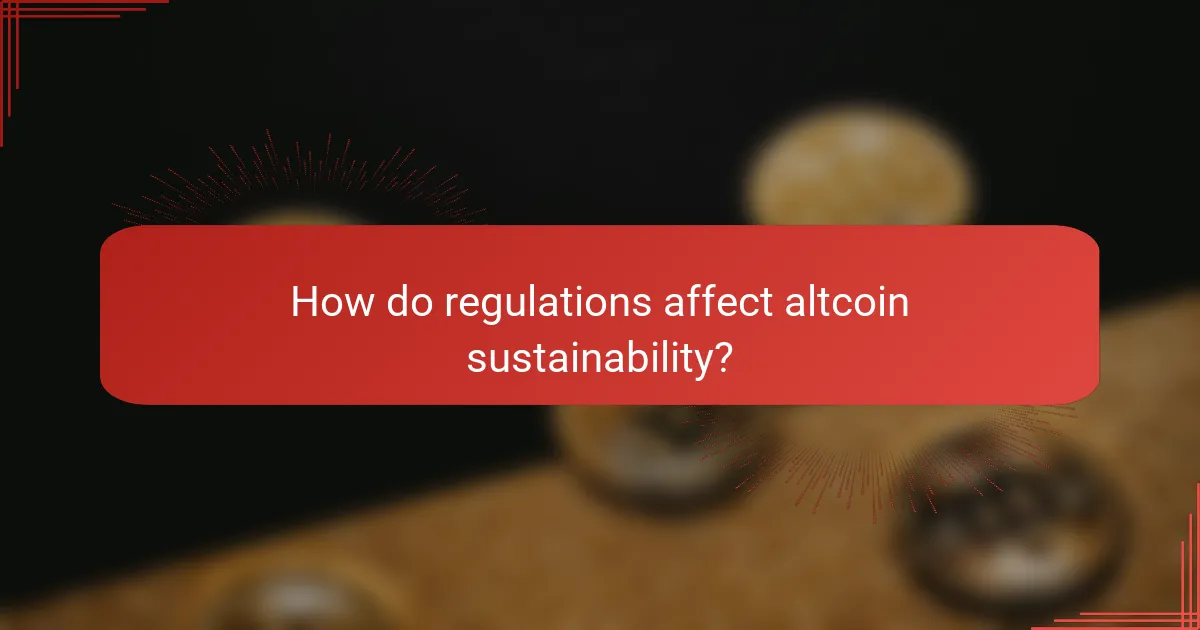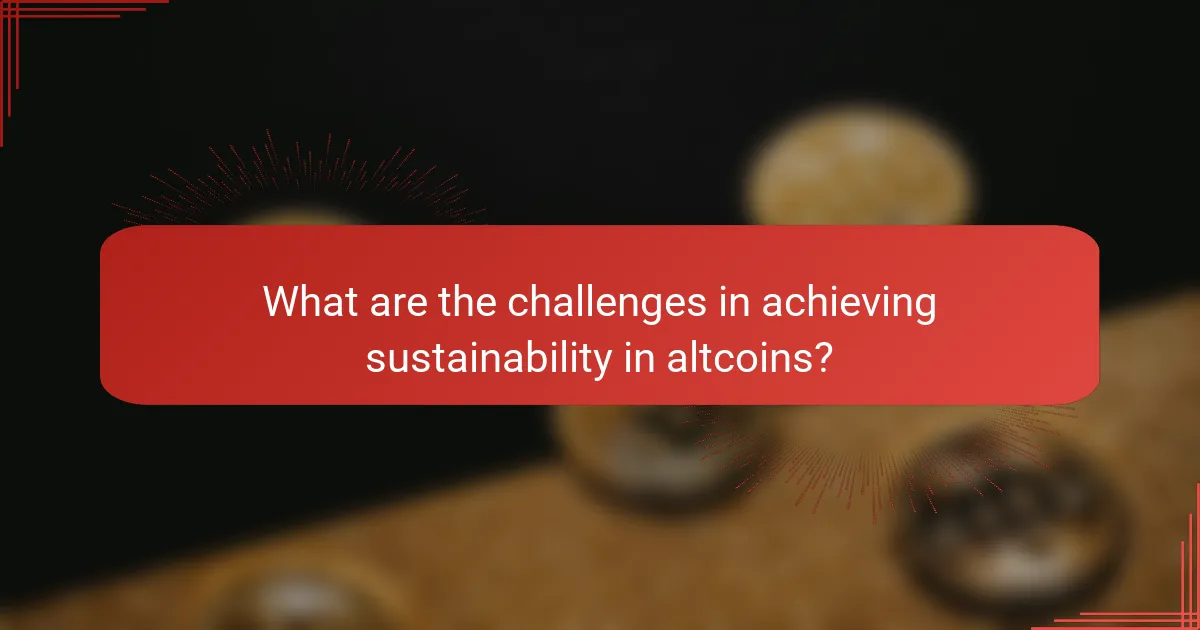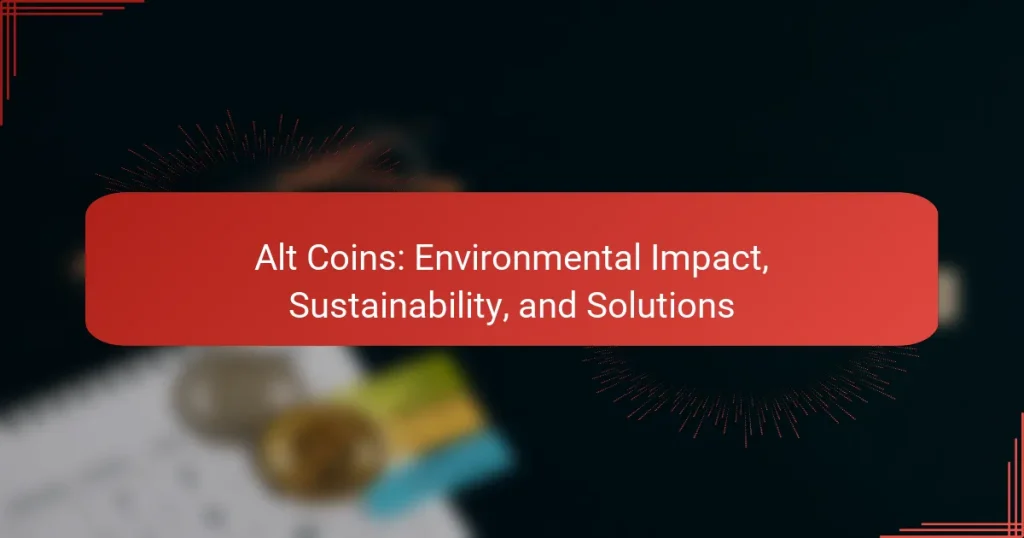Altcoins, while offering diverse opportunities in the cryptocurrency market, often face scrutiny for their environmental impact due to energy-intensive mining processes and high carbon footprints. Evaluating the sustainability of these projects is essential, as many are now adopting eco-friendly practices such as transitioning to proof-of-stake mechanisms and utilizing renewable energy sources. By focusing on sustainability, altcoins like Cardano, Algorand, and Tezos are leading the way in reducing energy consumption and promoting a greener future for digital currencies.

What are the environmental impacts of altcoins?
Altcoins can have significant environmental impacts primarily due to their energy-intensive mining processes, high carbon footprints, and the generation of electronic waste. Understanding these factors is crucial for evaluating the sustainability of various altcoin projects.
High energy consumption
Many altcoins, particularly those using proof-of-work consensus mechanisms, consume vast amounts of energy during mining. For instance, mining operations can require electricity equivalent to that of small countries, leading to concerns about sustainability and resource depletion.
To mitigate energy consumption, some altcoins are transitioning to more energy-efficient consensus methods, such as proof-of-stake, which significantly reduce the energy required for transaction validation. Users should consider the energy profiles of different altcoins when making investment decisions.
Carbon footprint of mining
The carbon footprint associated with altcoin mining is substantial, especially when the energy used is derived from fossil fuels. Estimates suggest that mining certain altcoins can produce carbon emissions comparable to those of major industrial sectors.
Investors and miners can reduce their carbon impact by opting for altcoins that utilize renewable energy sources or by supporting initiatives aimed at carbon offsetting. Awareness of the energy sources powering mining operations is essential for assessing their environmental sustainability.
Electronic waste generation
Altcoin mining contributes to electronic waste (e-waste) due to the rapid obsolescence of mining hardware. As technology advances, older equipment becomes inefficient and is often discarded, leading to environmental hazards if not properly recycled.
To address e-waste, miners and investors should prioritize the use of energy-efficient hardware and participate in recycling programs. Additionally, choosing altcoins that promote sustainable mining practices can help mitigate the e-waste problem associated with the industry.

How can altcoins become more sustainable?
Altcoins can enhance sustainability by adopting practices that reduce their environmental impact. Key strategies include transitioning to proof-of-stake mechanisms, utilizing renewable energy sources, and implementing carbon offset initiatives.
Transition to proof-of-stake
Transitioning to proof-of-stake (PoS) can significantly lower the energy consumption of altcoins. Unlike proof-of-work systems that require extensive computational power, PoS allows validators to create new blocks based on the number of coins they hold and are willing to “stake.”
This shift can reduce energy use by over 90% compared to traditional mining methods. For example, Ethereum’s move to PoS has set a precedent for other altcoins looking to decrease their carbon footprint.
Use of renewable energy sources
Utilizing renewable energy sources is another effective way for altcoins to become more sustainable. By powering mining operations with solar, wind, or hydroelectric energy, altcoin projects can significantly cut down on greenhouse gas emissions.
Some mining facilities are already investing in solar farms or locating near hydroelectric plants to harness clean energy. This approach not only supports sustainability but can also reduce operational costs in the long run.
Carbon offset initiatives
Carbon offset initiatives allow altcoin projects to compensate for their emissions by investing in environmental projects. These can include reforestation efforts, renewable energy projects, or carbon capture technologies.
Participating in such initiatives helps to balance out the carbon footprint generated by mining activities. Altcoins can partner with organizations that specialize in carbon credits to ensure their contributions are effective and verifiable.

What are the best eco-friendly altcoins?
The best eco-friendly altcoins are those that prioritize sustainability and have lower environmental impacts compared to traditional cryptocurrencies. Notable examples include Cardano, Algorand, and Tezos, each utilizing innovative technologies to reduce energy consumption and enhance efficiency.
Cardano (ADA)
Cardano is designed with a proof-of-stake consensus mechanism, which significantly reduces energy usage compared to proof-of-work systems. This approach allows users to validate transactions based on the number of coins they hold, rather than competing to solve complex mathematical problems.
Cardano’s commitment to sustainability is further demonstrated through its focus on academic research and peer-reviewed development. This ensures that its solutions are not only effective but also environmentally responsible, making it a strong choice for eco-conscious investors.
Algorand (ALGO)
Algorand operates on a unique consensus algorithm called Pure Proof of Stake, which minimizes energy consumption and allows for fast transaction processing. This system enables the network to handle thousands of transactions per second while maintaining a low carbon footprint.
Additionally, Algorand has initiatives aimed at carbon neutrality, including partnerships with organizations focused on environmental sustainability. This proactive approach enhances its appeal to those looking for green investment options in the cryptocurrency space.
Tezos (XTZ)
Tezos utilizes a liquid proof-of-stake model, which not only reduces energy consumption but also allows token holders to participate in governance decisions. This model encourages community involvement while ensuring that the network remains efficient and sustainable.
Tezos has been recognized for its commitment to eco-friendly practices, and its energy-efficient design makes it an attractive option for environmentally conscious users. By supporting Tezos, investors can contribute to a blockchain that prioritizes sustainability without sacrificing performance.

How do regulations affect altcoin sustainability?
Regulations play a crucial role in shaping the sustainability of altcoins by influencing mining practices, energy consumption, and environmental compliance. Governments can either promote eco-friendly technologies or impose restrictions that hinder sustainable development in the cryptocurrency space.
Government policies on mining
Government policies significantly impact altcoin mining by determining the legality and operational framework for mining activities. For example, some countries offer incentives for using renewable energy sources, while others may impose heavy taxes or outright bans on mining operations due to environmental concerns.
Countries like China have previously restricted mining due to high energy consumption, while nations such as Canada and Iceland promote mining through favorable energy policies. Miners must stay informed about local regulations to ensure compliance and optimize their operations.
Environmental regulations
Environmental regulations are designed to mitigate the ecological impact of mining and cryptocurrency transactions. These regulations often require miners to adhere to specific energy efficiency standards and emissions controls, which can drive the adoption of greener technologies.
For instance, the European Union has proposed regulations aimed at reducing the carbon footprint of cryptocurrency operations, pushing miners to transition to renewable energy sources. Altcoin projects that prioritize sustainability may benefit from regulatory support, enhancing their market appeal and long-term viability.

What are the challenges in achieving sustainability in altcoins?
Achieving sustainability in altcoins faces several significant challenges, including technological limitations, market resistance, and regulatory hurdles. These factors complicate the development and adoption of eco-friendly alternatives in the cryptocurrency space.
Technological limitations
Many altcoins rely on proof-of-work (PoW) mechanisms, which consume substantial energy and resources. Transitioning to more sustainable consensus algorithms, like proof-of-stake (PoS), can be technically complex and may require significant changes to existing networks.
Additionally, the infrastructure for supporting sustainable practices, such as energy-efficient mining operations, is still developing. Without advancements in technology, achieving a low-carbon footprint remains a challenge.
Market resistance
The cryptocurrency market often prioritizes profitability over sustainability, leading to resistance against eco-friendly initiatives. Investors may be hesitant to support altcoins that do not demonstrate immediate financial returns, despite their potential environmental benefits.
Furthermore, established altcoins with large user bases may resist changes that could disrupt their current operations. This inertia can slow the adoption of more sustainable practices across the market.
Regulatory hurdles
Regulatory frameworks for cryptocurrencies vary widely across countries, impacting the ability to implement sustainable practices. In some regions, lack of clear guidelines can hinder innovation in eco-friendly technologies.
Moreover, regulations may not incentivize sustainability, leading to a focus on compliance rather than environmental impact. Policymakers need to create supportive environments that encourage the development of sustainable altcoins.

What role do investors play in promoting sustainable altcoins?
Investors play a crucial role in promoting sustainable altcoins by directing capital towards projects that prioritize environmental responsibility. Their choices can significantly influence the market dynamics, encouraging developers to adopt eco-friendly practices and technologies.
Demand for eco-friendly options
The growing demand for eco-friendly options among investors is reshaping the altcoin landscape. Many investors are now prioritizing cryptocurrencies that utilize less energy-intensive consensus mechanisms, such as proof of stake, over traditional proof of work systems. This shift is prompting developers to innovate and create more sustainable alternatives.
Investors can assess the sustainability of altcoins by examining their energy consumption and carbon footprint. Tools and platforms that provide transparency regarding the environmental impact of various cryptocurrencies are becoming increasingly popular, allowing investors to make informed decisions.
Impact of ESG criteria
Environmental, Social, and Governance (ESG) criteria are becoming integral to investment decisions in the cryptocurrency market. Investors are increasingly evaluating altcoins based on their adherence to these standards, which can lead to greater funding for projects that demonstrate a commitment to sustainability and ethical practices.
As a result, altcoins that meet ESG criteria may experience enhanced market performance and investor interest. For instance, projects that implement carbon offset initiatives or contribute to renewable energy efforts are likely to attract more capital. Investors should consider these factors when selecting altcoins, as they can significantly influence long-term viability and growth.


